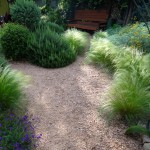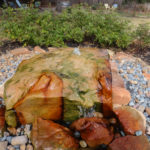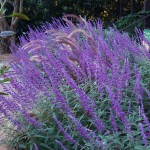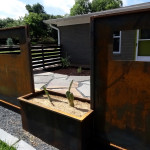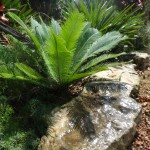Well, Alien life has been discovered, only much closer to home!
I found this ET hidden deep in the heart of one of my miscanthus grasses. I surmise it was relaying visual and telepathic data back to it’s mother ship. It really freaked us all out. We all hurried into the house, nailed the doors and windows shut, and immediately adorned our finely crafted foil hats, that we have on hand for such invasion occasions.

Red Wasp, Polistes carolina (Linnaeus) [Vespidae] I caught this one, cleaning itself on top of one of my gourds.
One of our common paper wasps is simply called red wasp or Texas red wasp.
This species is a dark red color with black wings. The paper wasp nest can be recognized by the paper nest that hangs from a single attachment point.
Adults in this family have the wings folded which gives them the appearance of having rather thin wings.
This wasp was somewhat intimidating, my hand was about a centimeter or two away from it as I took these shots, it just looks like it could pack a serious punch. I have never been stung by one (touch worm wood) so I don’t know. I learned that the males are incapable of stinging because the stinger on the females is a modified egg-laying structure (ovipositor) and it is not present in males.
Wasps feed on insects, including caterpillar pests, and therefore are considered to be beneficial insects.

I am ready for the imminent alien invasion armed with my
machete from the natural gardener!
While I was at the Natural Gardener this selection of ornamental cabbages caught my eye. Great winter color. I never seem to plant enough of them, close enough together to get a good effect. They look great crowded together like this. Next winter perhaps!

I did find this spotted cucumber beetle (Diabrotica undecimpunctata)
on one of my “sparsely” planted cabbages. I love the way these polka
dotted little demons look, I had so many of these vibrant bugs last year.

Ialso took a shot of the four clumps of mature Bamboo ‘Alphonse Karr’ that I have been writing
about recently at the Natural Gardener.
Bambusa Multiplex ‘Alphonse Karr’
It makes a stunning living screen.
I walked out of the Natural Gardener armed with this gothic, bewitching Witch Hazel :
Chinese Witch Hazel, Chinese Fringe Flower ‘Burgundy’ (Loropetalum chinense var. rubrum)
see if it will make it through a Texas summer?
a syrup, was used by Native Americans for coughs and fever. The Cherokee
tribes of North American made a potion of its leaves and bark and found it
soothing, cooling and astringent.
Finally,
Because of its unusual life cycle, witch hazel also seems to be responding to
an otherworldly force, operating on a different calendar than most plants.
My plant is in full bloom right now.
Folklore tells us that underground water and mines can be found by walking
an area carrying a forked twig of Witchhazel loosely in your hands until the
twig bends downward, pointing to where to dig for water. This type of water
divination is know as Virgula divina, or
My succulent bed seems to be doing fine so far this winter. This bed had a bunch of leaves in it that I thought would help with insulating the plants from the cold. I am currently reading “Designing with Succulents” by Debra Lee Baldwin, a great book with equally great illustrations. I learned that all debris should immediately be removed from succulent beds because the leaves can trap in moisture and rot these plants, makes sense. Here it is after getting a sprucing, there are still quite a few things still blooming in here, some just about to.
Here are a few shots of some of the “bloomers.” I have absolutely no idea what the names are for these two plants so if anyone can help me out here.
surrounding the main trunk. These palms
make fantastic specimen plants and
are also extremely cold hardy and compact.
This will look great in this bed and provide
some dappled afternoon shade.
Somehow during my frantic raking I must have hooked this poor plant. I turned around and it was gone! It was a real shame because it was just about to bloom and was thriving. I looked for it for a while, then abandoned the search.
I recently cut back all my ornamental grasses and did my winter clean up…pulling the dead growth from my pampas, picking up leaves from my beds, cutting back my mexican bush sage, a general tidy up. The consequence of this was my already large brush pile went immediately onto steroids.
It is now completely out of control. I will get a shredder for a day soon and take care of this mountain once and for all. There has to be some great compost at the heart of this “hut”, after all, this cake has been baking in the sun for the last seven years!


Remember that “Rat Tailed Maggot” in my rainwater collection tank?
Syrphids are also known as flower flies or hover flies. Brrrr. Once again, very gothic.

Jumping spiders are generally recognized by their eye pattern. They typically have eight eyes arranged in two or three rows. The front, and most distinctive row is enlarged and forward facing to enable stereoscopic vision.
Jumping spiders are known for their natural curiosity. If they are approached by a hand, instead of scuttling away as most spiders do, this jumping cheeky monkey will usually leap and turn to face the hand. Continue approaching and the spider may jump backwards while still eyeing your hand. The tiny creature will even raise its forelimbs to “hold its ground”. Because of this contrast to other arachnids, the jumping spider is regarded as inquisitive and interested in whatever approaches it. Hence how I got the lens so close to this one on a post on my back deck. He was standing his ground on the battlefield. He kept turning to face the camera!
William Wallace climbed down off his pedestal at the back of my yard and immediately shuffled over to recruit the little chap. (He has stone legs afterall)
that Obama has already “pushed” (ahem)
through Congress.
Note: contains “colorful” language
“Ah, ha, ha, ha, stayin’ alive, stayin’ alive.”
All material © 2009 for east_side_patch. Unauthorized reproduction prohibited.






































